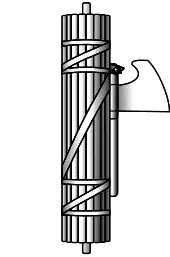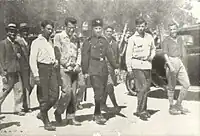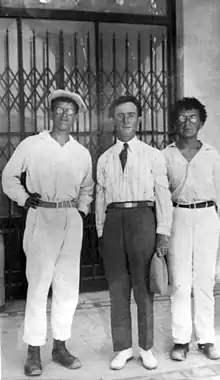Brit HaBirionim ברית הבריונים | |
|---|---|
| Historical leaders | Abba Ahimeir Uri-Zvi Greenberg Yehoshua Yeivin |
| Founded | 1930 |
| Dissolved | 1933 |
| Headquarters | Jerusalem |
| Ideology | Revisionist Zionism Revisionist Maximalism Fascism Fascist corporatism Anti-communism |
| Political position | Far-right |
| Religion | Judaism |
| Colors | Black (official) Blue (informal) |
| Part of a series on |
| Fascism |
|---|
 |
Brit HaBirionim (Hebrew: ברית הבריונים, variously translated as The Strongmen Alliance,[1] Alliance of Thugs,[2] Alliance of the Hoodlums,[3] and The Covenant of the Outlaws[4]) was a clandestine, self-declared fascist faction of the Revisionist Zionist Movement (ZRM) in Mandatory Palestine, active between 1930 and 1933.[5][6] It was founded by the trio of Abba Ahimeir, Uri Zvi Greenberg and Yehoshua Yeivin.
History
The 1929 Palestine riots and the Haganah's inability to successfully prevent the massacres in Hebron and Safed led to the creation of the first militant organization characterized by its complete disassociation from the existing Zionist establishment dominated by the Labor Zionist movement.[7] Brit HaBirionim was founded in October 1930 and was right-wing and nationalist in its orientation as opposed to the current of Labor Zionism.[3]
Ideology
The organization's official ideology was Revisionist Maximalism, which was modelled upon Italian Fascism.[5][6][8] Italian influence could be seen in the fact that leaders Ahimeir and Greenberg called upon Ze'ev Jabotinsky to become 'duce'.[9][10] Similarly, it sought to create a fascist corporatist state.[8] However, it was also influenced by the Canaanite ideology of Yonatan Ratosh, as well as the theories of Oswald Spengler in The Decline of the West (1918).[8][10] The group also took profound influence from the ancient Jewish Sicarii insurgents.[3]
It called for the Zionist Revisionist Movement (ZRM) to adopt the fascist principles of the regime of Benito Mussolini in Italy to create an integralist "pure nationalism" amongst Jews.[11] Revisionist Maximalism rejects communism, humanism, internationalism, liberalism, pacifism and socialism; condemned liberal Zionists for only working for middle-class Jews rather than the Jewish nation as a whole.[12][13] Revisionist Maximalism's minimal goals were presented in 1932 where Ahimeir officially called for the leadership of the Zionist Revisionist Movement to be redesigned into the form of a dictatorship, called for the creation of an independent Zionist federation, called for a "war on funds" to end corruption in the Zionist movement, and called for a war on anti-Semitism.[14] The movement's psychology was emphasized in its motto of "conquer or die".[8]
Operations

Members of Brit HaBirionim carried out several operations, including demonstrations against visiting British dignitaries, rallies against the British arrest and deportation to Europe of Jewish refugees who overstayed their tourist visas, attempts to interrupt a census conducted by the British, and other illegal activities intended as public provocations such as blowing the Shofar at the Western Wall (forbidden to Jews at that time), and removing the Nazi flags from two German consulates.[15][16]
In 1933, the British Mandatory Authority arrested several members, including Ahimeir, and charged them with the murder of Chaim Arlosoroff. Though acquitted of the charges in 1934, the trial tarnished the group's reputation and led to its isolation by former political supporters among the Jewish populace, and eventually to its demise.
Many of the group's adherents would later become members of Irgun and Lehi.[17] Gershon Schatz for instance joined Lehi.[18]
References
- ↑ Casif, Erez (2014-01-08). Why was the State of Israel 'Really' Established?. Cambridge Scholars Publishing. ISBN 978-1-4438-5563-1.
- ↑ Assaf Sharon,'The Moral Siege,' Boston Review August 05, 2014.
- 1 2 3 Ben-Yehuda, Nachman (1996-01-01). Masada Myth: Collective Memory and Mythmaking in Israel. Univ of Wisconsin Press. ISBN 978-0-299-14833-1.
- ↑ Gur-Ze'ev, Ilan (1997). "Total Quality Management and Power/Knowledge Dialectics in the Israeli Army". Journal of Thought. 32 (1): 9–36. ISSN 0022-5231. JSTOR 42589479.
- 1 2 Kaplan, The Jewish Radical Right. University of Wisconsin Press, 2005. p15
- 1 2 Shindler, Colin. The Triumph of Military Zionism: Nationalism and the Origins of the Israeli Right. I.B.Tauris, 2006. p13.
- ↑ Weinberg, Leonard; Ami Pedahzur (2004). Religious fundamentalism and political extremism. Routledge. p. 97. ISBN 978-0-7146-5492-8.
- 1 2 3 4 Ofira Seliktar. New Zionism and the foreign policy system of Israel. Beckenham, England, UK: Croom Helm, Ltd., 1986. Pp. 84
- ↑ Peleg, Ilan (2005). "The Zionist Right and Constructivist Realism: Ideological Persistence and Tactical Readjustment". Israel Studies. 10 (3): 127–153. doi:10.2979/ISR.2005.10.3.127. ISSN 1084-9513. JSTOR 30245770. S2CID 144141400.
- 1 2 McGlynn, Margaret (2004-12-20). The Royal Prerogative and the Learning of the Inns of Court. Cambridge University Press. ISBN 978-0-511-05737-3.
- ↑ Larsen, p364-365.
- ↑ Kaplan, p15
- ↑ Shindler, Colin. The Triumph of Military Zionism: Nationalism and the Origins of the Israeli Right. I.B.Tauris, 2006. p156.
- ↑ Larsen, Stein Ugelvik (ed.). Fascism Outside of Europe. New York: Columbia University Press, 2001. ISBN 0-88033-988-8. p378.
- ↑ Golan, Zev. Free Jerusalem: Heroes, Heroines and Rogues Who Created the State of Israel, (Israel: Devora, 2003), pp. 49-53, 66-77.
- ↑ "Terrorism Experts". Archived from the original on 2007-12-17. Retrieved 2007-12-02.
- ↑ Ben-Yehuda, Nachman (2012-02-01). Political Assassinations by Jews: A Rhetorical Device for Justice. SUNY Press. ISBN 978-0-7914-9637-4.
- ↑ "נסיכי הליכוד: ילדי המחתרת שהפכו למנהיגי המדינה" ["The Likud princes: the children of the underground who became the leaders of the state"]. Makor Rishon (in Hebrew). 2015-04-17. Retrieved 2023-09-03.
